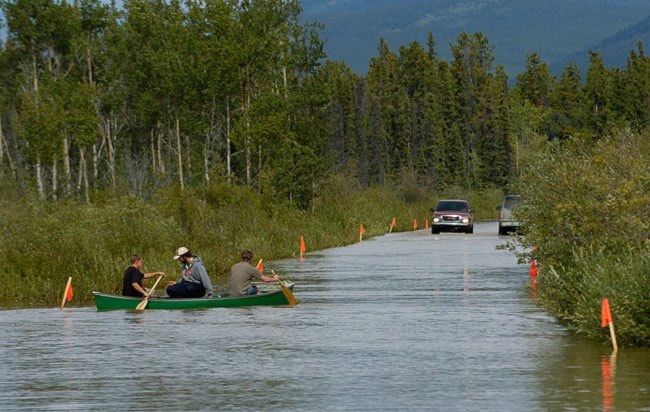Early reports show no serious risks of spring and summer floods across the territory. But government hydrologists are keeping their eyes on some areas where that could change in a hurry.
Rock Creek, Old Crow, Ross River and Upper Liard have been assigned a moderate risk of flooding. The chance of disaster striking will depend on temperatures, rainfall and luck as the winter snow and ice melts into summer.
Snowpack conditions across the territory as of April 1 were highly variable.
Faro and Ross River showed snowpack levels more than 30 per cent above normal, while regions around Haines Junction and Old Crow were 10-30 per cent below normal.
Melting snow is the primary contributor to high water levels and flood conditions, said Ric Janowicz, the government’s manager of hydrology.
But the earliest type of flood that the territory might see would be due to an ice jam.
As river ice breaks up, under certain conditions it can become blocked, forming a dam and flooding an area upstream.
A colder winter across the territory means thicker ice along the rivers, which increases the risk of a flood.
It also matters how quickly spring comes. If the melt is gradual, the rivers are more likely to “mush out,” said Janowicz. However, if cold weather quickly turns warm, large, strong blocks of river ice can be released, and the chance of damming increases.
If the current below-normal temperatures turn around quickly, we could see this sort of event.
One area that’s being closely watched is downstream from Old Crow, where the Bluefish River flows into the Porcupine River.
There, ice and water from the Bluefish has flowed over the Porcupine, creating a much thicker layer of ice in that area, which is known as an aufeis formation.
Currently the aufeis has reached the far shore of the Porcupine, and a secondary ridge of aufeis, two metres high, is also crawling across.
That section of ice is much more likely to dam, as thinner ice upstream will melt more quickly and could be held back by the aufeis. That could result in flooding in Old Crow.
It all comes down to timing, said Janowicz, and the area will be closely monitored.
Breakup on the Porcupine is expected around the second week of May.
The government will produce weekly risk updates over the flooding season, or more frequently where circumstances require it.
Contact Jacqueline Ronson at
jronson@yukon-news.com
